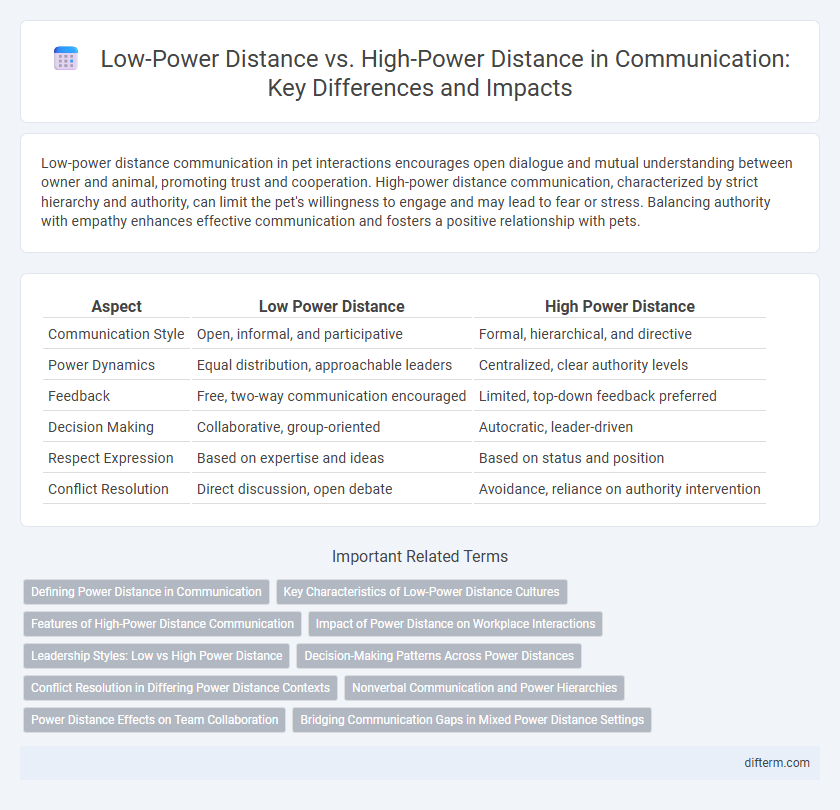Low-power distance communication in pet interactions encourages open dialogue and mutual understanding between owner and animal, promoting trust and cooperation. High-power distance communication, characterized by strict hierarchy and authority, can limit the pet's willingness to engage and may lead to fear or stress. Balancing authority with empathy enhances effective communication and fosters a positive relationship with pets.
Table of Comparison
| Aspect | Low Power Distance | High Power Distance |
|---|---|---|
| Communication Style | Open, informal, and participative | Formal, hierarchical, and directive |
| Power Dynamics | Equal distribution, approachable leaders | Centralized, clear authority levels |
| Feedback | Free, two-way communication encouraged | Limited, top-down feedback preferred |
| Decision Making | Collaborative, group-oriented | Autocratic, leader-driven |
| Respect Expression | Based on expertise and ideas | Based on status and position |
| Conflict Resolution | Direct discussion, open debate | Avoidance, reliance on authority intervention |
Defining Power Distance in Communication
Power distance in communication refers to the degree to which less powerful members of a society accept and expect unequal power distribution during interactions. Low-power distance cultures promote open dialogue, egalitarian exchanges, and emphasize accessibility between different hierarchical levels. High-power distance communication often involves formal language, deference to authority, and limited feedback from subordinates to superiors.
Key Characteristics of Low-Power Distance Cultures
Low-power distance cultures emphasize equality and open communication between individuals of different hierarchical levels, fostering an environment where subordinates feel comfortable expressing opinions and challenging authority. Decision-making tends to be more democratic, with leaders acting as facilitators rather than authoritarian figures. Transparency, collaboration, and mutual respect are defining traits, promoting inclusive dialogue and reducing power-related barriers in organizational and social interactions.
Features of High-Power Distance Communication
High-power distance communication features strict hierarchical structures where subordinates show deference and rarely question authority. Communication flows primarily top-down, emphasizing formality, indirectness, and respect for status differences. In these cultures, maintaining harmony and avoiding open conflict are prioritized to preserve power dynamics.
Impact of Power Distance on Workplace Interactions
Low-power distance fosters open communication, encouraging employees at all levels to share ideas and challenge authority, which enhances collaboration and innovation. High-power distance creates hierarchical barriers, leading to limited feedback and communication primarily flowing from top to bottom, often reducing employee engagement and slowing decision-making. Understanding these dynamics enables organizations to tailor leadership styles that improve workplace interactions and overall productivity.
Leadership Styles: Low vs High Power Distance
Low-power distance leadership emphasizes collaboration, open communication, and employee empowerment, fostering innovation and trust within teams. High-power distance leadership relies on hierarchical structures, centralized decision-making, and clear authority lines, which can streamline command but may limit feedback and creativity. Understanding these leadership styles is crucial for adapting communication strategies in multicultural organizations and enhancing team dynamics.
Decision-Making Patterns Across Power Distances
Decision-making patterns in low-power distance cultures emphasize collaborative participation, open dialogue, and shared responsibility, fostering inclusive communication channels. In contrast, high-power distance cultures centralize decision-making authority within hierarchical structures, limiting input from lower-level members and reinforcing top-down communication. Understanding these dynamics enhances cross-cultural interactions by adapting communication strategies to respect power distance variations.
Conflict Resolution in Differing Power Distance Contexts
In low-power distance cultures, conflict resolution emphasizes open dialogue, equality, and collaborative problem-solving, allowing subordinates to voice concerns freely. High-power distance contexts prioritize hierarchical authority, where conflicts are often resolved through top-down decisions and deference to seniority. Understanding these dynamics is crucial for effective communication and negotiation across diverse cultural environments.
Nonverbal Communication and Power Hierarchies
Low-power distance cultures exhibit nonverbal communication marked by direct eye contact, relaxed postures, and equal physical space, reflecting flatter power hierarchies. In contrast, high-power distance cultures use nonverbal cues like avoiding eye contact, formal gestures, and increased physical distance to emphasize authority and reinforce clear social rankings. Understanding these differences is essential for effective communication and cultural sensitivity in global interactions.
Power Distance Effects on Team Collaboration
Low-power distance promotes open communication and egalitarian relationships, fostering greater collaboration and innovation within teams. High-power distance often leads to hierarchical structures where subordinates are less likely to share ideas, which can stifle creativity and slow decision-making. Understanding power distance effects helps organizations design communication strategies that enhance mutual respect and effective teamwork.
Bridging Communication Gaps in Mixed Power Distance Settings
Bridging communication gaps in mixed power distance settings requires fostering open dialogue that respects hierarchical structures while encouraging inclusive participation. Emphasizing active listening and adaptive communication strategies reduces misunderstandings between low-power distance individuals who prefer egalitarianism and high-power distance counterparts valuing authority. Leveraging culturally sensitive approaches enhances mutual respect, enabling smoother collaboration across diverse organizational or cultural power dynamics.
low-power distance vs high-power distance Infographic

 difterm.com
difterm.com